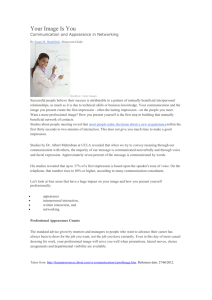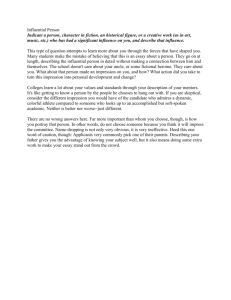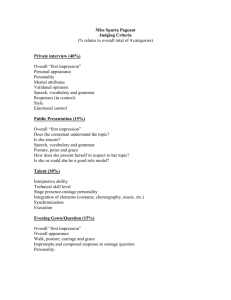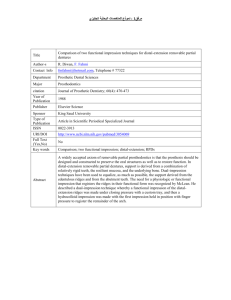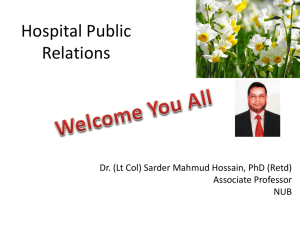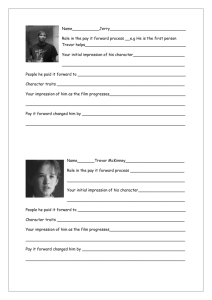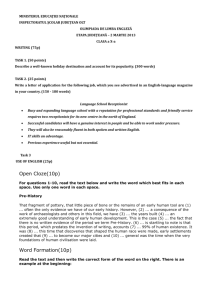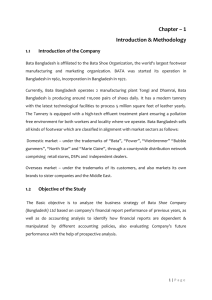II. First Impressions Are Lasting Impressions
advertisement
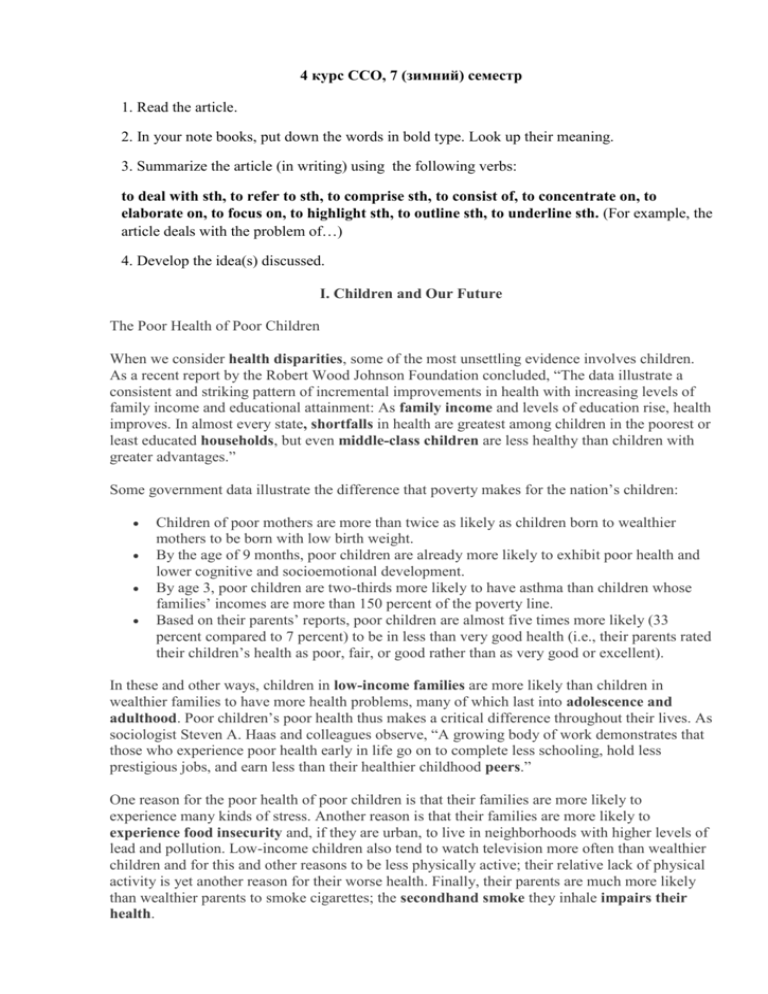
4 курс ССО, 7 (зимний) семестр 1. Read the article. 2. In your note books, put down the words in bold type. Look up their meaning. 3. Summarize the article (in writing) using the following verbs: to deal with sth, to refer to sth, to comprise sth, to consist of, to concentrate on, to elaborate on, to focus on, to highlight sth, to outline sth, to underline sth. (For example, the article deals with the problem of…) 4. Develop the idea(s) discussed. I. Children and Our Future The Poor Health of Poor Children When we consider health disparities, some of the most unsettling evidence involves children. As a recent report by the Robert Wood Johnson Foundation concluded, “The data illustrate a consistent and striking pattern of incremental improvements in health with increasing levels of family income and educational attainment: As family income and levels of education rise, health improves. In almost every state, shortfalls in health are greatest among children in the poorest or least educated households, but even middle-class children are less healthy than children with greater advantages.” Some government data illustrate the difference that poverty makes for the nation’s children: Children of poor mothers are more than twice as likely as children born to wealthier mothers to be born with low birth weight. By the age of 9 months, poor children are already more likely to exhibit poor health and lower cognitive and socioemotional development. By age 3, poor children are two-thirds more likely to have asthma than children whose families’ incomes are more than 150 percent of the poverty line. Based on their parents’ reports, poor children are almost five times more likely (33 percent compared to 7 percent) to be in less than very good health (i.e., their parents rated their children’s health as poor, fair, or good rather than as very good or excellent). In these and other ways, children in low-income families are more likely than children in wealthier families to have more health problems, many of which last into adolescence and adulthood. Poor children’s poor health thus makes a critical difference throughout their lives. As sociologist Steven A. Haas and colleagues observe, “A growing body of work demonstrates that those who experience poor health early in life go on to complete less schooling, hold less prestigious jobs, and earn less than their healthier childhood peers.” One reason for the poor health of poor children is that their families are more likely to experience many kinds of stress. Another reason is that their families are more likely to experience food insecurity and, if they are urban, to live in neighborhoods with higher levels of lead and pollution. Low-income children also tend to watch television more often than wealthier children and for this and other reasons to be less physically active; their relative lack of physical activity is yet another reason for their worse health. Finally, their parents are much more likely than wealthier parents to smoke cigarettes; the secondhand smoke they inhale impairs their health. The clear evidence of poverty’s effects on the health of poor children underscores the need of the United States to do everything possible to minimize these effects. Any money spent to reduce these effects will pay for itself many times over throughout these children’s lifetimes: They will have fewer health problems as they grow up, costing the United States much less in health care, and be better able to do well in school and to have higher incomes as adults. In both the short run and long run, then, improving the health of poor children will also improve the economic and social health of the whole nation. (2012books.lardbucket.org›…problems…health-inthe…) II. First Impressions Are Lasting Impressions Whether you are going to an interview or starting your first day at work, it’s important to make a great first impression! Of course, you’ve heard it all before, but how can you be sure your first impression is a positive one? Studies show that a lasting impression will be formed of you within 30 seconds to ten minutes of meeting you, and this impression will last! So what are the tricks, tips and all the good bits that can be shown off about your personality in these ten minuets to make a great lasting first impression? Firstly let’s get rid of the clichés in this scenario! The strong handshake and not arriving late are the bear basics of the first impression and hopefully you know them already! Your body language is the most important part to the art of a good impression! Studies show that 70 % of what you say is conveyed by your body language and a further 10% by the tone of your voice. This means that 80% of what you’re actually saying isn’t the words you are speaking at all. Standing tall, not slouching and making good eye contact is a great place to start when meeting someone new, as this will convey confidence and ability. If you are sitting down, don’t fold your arms or create what is called a unconscious barrier to you. Sit with your hands out and have an open, welcoming posture; smile and listen – we were given one mouth and two ears for a reason! This will lead you onto the second part to help develop a great first impression. Making good conversation! You may have already accounted for 80% of a conversation, but you’ve still got 20% to fill. This is a virtuous circle, the more conversation you make, the better you get at it and the more you will converse, so everyone is a winner, but remember that there’s a difference between good conversation and small talk! It’s very easy to spot small talk, it’s irrelevant and forgettable, an engaging conversation will leave a positive lasting impression. Whether it’s a job you are going for or your first day; Research the company! Know what they do, how big they are, where they have offices etc, you don’t want to be left looking dumbfounded if someone asks you a question about the company. It takes 10 minutes to look into a company’s profile and shows that you are committed to the company from an early stage. No matter how advanced our technology may be getting, it will always be important to make a personable good first impression! So make sure you’re prepared for your first interview and your first day. (eurolondon.com›blog…first-impressions-are-lasting…) III. Yes, Obi-Wan, There Still Are Books For the first few centuries after Johann Gutenberg started churning out Bibles, books had it easy. There were paintings, songs and sermons, of course, but movable type applied to paper was the cutting-edge technology for telling stories. Today, books compete with DVD's, video games, 500 channels of cable television and a nearly limitless number of pages on the Internet. The good news is that even in this high-tech age, old-fashioned books appear to be holding their own. In the three years that ended last December, consumer spending on books rose 8 percent, to nearly $21 billion, as Edward Wyatt reported in The Times last week. Spiritual books like "The Purpose-Driven Life," which has sold more than 22 million copies since 2002, and books with religious themes, like "The Da Vinci Code," have been selling particularly briskly. Political books, both conservative and liberal, have also done well. Remarkably, Americans still spend more on books than they do on movie going, recorded music, video games or DVD's. Despite all the advances in technology, books still have no equal when it comes to telling complicated, nuanced narratives. The news on book sales is not all good. The driving force behind the increase in revenue is higher prices, not more books sold. In fact, the number of books sold has declined 3 percent in the last three years. And the National Endowment for the Arts found, in a report released last year, that literary reading had declined sharply among adults over the past two decades. That means there is still a need for all of the well-known prescriptions: better English instruction in the schools, more literacy programs and more money for libraries. Still, in an age when air travelers canwatch a Hollywood movie on their laptops, and video game players can live in a virtual city in their computers, a gratifyingly large number of Americans still want to curl up with a good book. IV. Travel broadens the mind - not! By Paul Myers The adage goes that travel broadens the mind. However my experiences of flights between match sites during an Africa Cup of Nations run counter to that saying. I feel voyages just confirm my fears. As a Cup of Nations debutant in Ghana in 2008, flights from Accra to Kumasi or Tamale and back were, for me, gruesome affairs. In Angola two years ago, I was, by comparison to the first trip, more seasoned. But in Angola moving between Luanda and the three other match venues, I entered a vortex of Kafkaesque incompetence. The trip to Bata for the semi-final between Ghana and Zambia was seeped in the indifference that the administrators of this tournament lavish on the paying public. A flight chartered by the organising body COCAN was scheduled to leave Libreville at 13.30 for Bata. The idea being that the 25 minute flight between the capitals of the two co-hosts should leave supporters and journalists plenty of time to reach the stadium for the kick-off at 17.00. Well the plane left around 35 minutes late but it didn’t matter. The Ghana supporters were dancing and singing songs of joys to come against Zambia. The plane arrived at 14.40 in Bata. Technically this should not have been a problem. But customs/border control officers in Equatorial Guinea clearly hadn’t been factored in. You need to have finger prints and a photograph taken before you’re allowed to enter the country. I’ve got no issue with that but there weren’t that many people dealing with a plane load of 200 passengers. Besides it was searingly hot in the converted hangar. Before tempers can rise, the air conditioning system gurgles into life. Within minutes the inferno is transformed into Ice Station Zebra and a man in a white, collarless shirt with rather fetching black buttons, emerges centre stage. He strides between the bank of four officers with a concerned visage. A few hapless souls trundle past and then the computers break down. We wait. By the time the machines are reanimated, the collarless controller has returned with a walkietalkie and furrowed brows. People are processed but it is laborious and the Ghana supporters aren’t singing any more. As for my own plight, I’m through the hi-tech party by 15.30, nearly 50 minutes after landing. But then we descend into the lo-fidelity waveband. My passport – along with several others - is taken away by the collarless shirt into a hut marked Policia. Eight minutes later he comes out and starts clutching the passports open for the supposed holders to claim. My passport which is swaddled in a Paris Metro map holder – a yuletide present from my clearly prescient daughters – is easily recognisable. An hour or so has passed since getting off the plane. Fortunately the journey from the airport to the stadium took just over 20 minutes so I was there with about 45 minutes to spare before the teams emerged. Leaving Equatorial Guinea was even more difficult which I find odd. I would have thought if the authorities are so reluctant to let people in, then they’d be keen to get rid of them. No. Only one woman on duty to check in all the people who’d been on the plane earlier. And as she told around 40 Ghanaian journalists: the plane doesn’t leave until I’ve dealt with you all. What I particularly liked were a couple of Gabonese journalists who said they had priority because they were Gabonese journalists. The Ghanaians didn’t wear that too well – their team had just been turned over 1-0 by the unfancied Zambians. As voices rose, I managed to extricate myself from the impending war zone; I’m a sports reporter not a conflict correspondent. The flight to Libreville – scheduled for 21.30 – did indeed leave late. Well past 10pm. The Bata airport experience was inefficient, crude, dehumanizing and illogical. True Bata airport is not Equatorial Guinea but it is the initial encounter and as the corporate shtick goes: you only get one chance to make a first impression. Has my mind been broadened by my day trip? Am I wiser for the journey? It certainly doesn’t feel that way. But of course I am. At the airport I managed to remain calm if quizzical. My Cup of Nations travels over the years have ameliorated my tolerance levels but not to the point of being world weary. There’s still room in life for surprise. And that’s no bad thing. Unless you’re a Ghana fan. V. Are You Multitasking or Are You Suffering from Digital-Device-Distraction Syndrome? Nov. 12, 2012 As technology invades our lives and covers every facet of working, playing, learning and more, we as a culture will need to adjust and find balance so as to not get so lost in the digital world that we lose ourselves. We hear frequently about parents desiring to get their kids to shut off the video-game systems and go outside and play. Go out in public to restaurants, coffee shops and malls, and you see people fixated on their screens. There is nothing wrong with that, however, I think we need to be aware of something important as a digital society. I fear that we may slowly lose the ability to be fully present in a moment or situation. I noticed this about myself a few years ago while I was on my computer checking e-mail and responding to “important” work stuff. As I was sitting there fully immersed in my screen, one of my daughters was trying to get my attention. I’m not sure how long it took, but I think she had to say, “Daddy! Daddy! Daddy!” about four or five times. I recognized that it should not take me that long to respond, and, more importantly, my eyes were open to the reality that often I was not fully present in many important situations. We are allowing digital distractions to interfere with important moments. Since then, I have worked to retrain myself to be more fully present when engaging in conversations with my family, friends and colleagues. And I’m resisting the urge to constantly look at my phone to see if I have new e-mail, check Twitter or Facebook or do something that would send a signal to the person across from me that they don’t matter as much as something on my digital device. Perhaps this is not a problem everyone struggles with, but I am noticing it more and more with young people. I grew up with technology and have little or no recollection of life without a game system or personal computer. I am in my mid-30s and the digital devices I grew up with are light-years different from the ones my kids are growing up with, but the point remains that growing up digital leads to some of the tendencies I am noticing. There’s a lack of ability to be fully present. I especially notice this problem being rampant where I live and work in Silicon Valley. Just the other day I was observing at a restaurant in Palo Alto, Calif., that’s popular for many business-lunch meetings that most, if not all, of those engaging with other humans were also equally engaged in their digital devices. I watched three different tables and in a time period of 15 minutes, every person at every one of those tables averaged checking their smart phones and responding to something at least three times. This is clearly just becoming something that is socially acceptable. In a meeting or conversation, it’s O.K. to turn our attention and be as equally engaged with a smart phone as we are with the person across from us. We are, after all, a multitasking generation. In fact, an interesting thread comes up in some of our firm’s consumer interviews that are focused around computing. Very often, the desire to multitask and be engaged with multiple things at one time is a common one when it comes to computing products. We are becoming not just comfortable with multitasking but we are also becoming experts at it. Multitasking extends from multiple tasks on a single screen to multiple tasks divided to multiple screens. More common in many households in developed countries is the use of a second screen while watching TV. Whether it is a tablet, smart phone or notebook, we are now engaging with multiple tasks on multiple screens, often at the same time. Our attention is divided across multiple tasks and multiple screens. I’m guessing that the prior generation may have considered this too much to handle. We are becoming experts in multitasking, but I think it’s time we learn again how to single-task in certain situations and contexts, namely during engagements with human beings. I am working to do this and I hope to bring my kids up with a heightened awareness of how and when it is important to exercise single-tasking — the importance of being present and engaged in a moment. Relationally, this is a key skill I’d love to see reacquired by the digital generation. It will not be easy. Screen media competes for our attention and will continue to do so many times during our days. I’d love to see companies like Apple, Microsoft and Google even try to help turn this trend around — perhaps by offering technology like Apple’s Do Not Disturb feature to automatically kick in when I am in a meeting or when I get home. There is a time and place for technology, but there is also a time and place to be present in the real world. If we can’t recapture the ability to be present, we may find that digital distractions cause life to pass us by. VI. Arts Help Build New Economy Workforce Skills The arts are one tool used by states to enhance workforce readiness for students in both the general and at-risk populations. Programs incorporating the arts have proven to be educational, developmentally rich, and cost-effective ways to provide students the skills they need to be productive participants in today’s economy. Arts programs combine academic and workforce development skills in a manner attractive to participants of all age groups and economic backgrounds. Children raised in higher socioeconomic brackets and exposed to the arts through other sources such as families and communities reap the benefits of these activities. In general, at-risk children lack the resources available to other children, are less likely to be introduced to the arts, and lose out on the important educational advantages that the arts can provide. Arts education can have a beneficial and enriching effect on all children, but in some cases, the effects on at-risk children are even more dramatic, especially among those from lowincome situations. Research reveals that when young people study the arts they show heightened academic standing, a strong capacity for self-assessment, and a secure sense of their own ability to plan and work for a positive future. Research reveals that when young people (both general and atrisk populations) study the arts they show heightened academic standing, a strong capacity for self-assessment, and a secure sense of their own ability to plan and work for a positive future. The report, Champions of Change: The Impact of the Arts on Learning reviews research conducted by scholars from Columbia University’s Teachers College, Harvard University, Harvard’s Project Zero, Stanford University, the University of California at Los Angeles, and the University of Connecticut. The researchers found that arts education can enhance academic achievement, reach students on the margins of the educational system, create an effective learning environment, and connect learners’ experiences to the world outside of school. Multiple studies cite strong positive impacts across socioeconomic groups with respect to both academic and personal success. Other studies of the effects of arts instruction on learning have found that children who study the arts are: • four times more likely to be recognized for academic achievement; • elected to class office within their schools three times as often; • four times more likely to participate in a math and science fair; • three times more likely to win an award for school attendance; and • four times more likely to win an award for writing an essay or poem. In addition to academic success, students introduced to arts education have heightened soft skills. In a study of more than 2000 middle school students in four states, researchers at Columbia University found that children receiving at least three years of in-school arts instruction scored significantly higher on quantitative tests of creative thinking than their peers with less arts instruction. Students with more arts instruction had index scores averaging 20 points higher than their peers on measures of creative thinking, fluency, originality, elaboration and resistance to closure. Some critics have argued that arts curricula may not produce increased standardized test results. An analysis of 188 previous studies describing correlations between the arts and performance on mathematics and verbal skills tests found a causal link between studying the arts and improved academic performance in only 3 of 10 areas studied. Researchers Ellen Winner and Lois Hetland, in Harvard’s Reviewing Education and the Arts project, urged caution with respect to justifying arts education programs on the sole basis of instrumental grounds such as test scores. The arts contribute significantly to the creation of the flexible and adaptable knowledge workers that businesses demand to compete in today's economy. Nonetheless, arts education appears to develop cognitive skills and traits which may or may not be easily measured through standardized testing. According to Dr. Elliot W. Eisner of Stanford University, schooling in the arts has cognitive effects that help prepare students for the 21st-century workforce. Eisner identifies key competencies of cognitive growth that are developed through an education in the arts. These include: • perception of relationships; • skills in finding multiple solutions to problems; • attention to nuance; • adaptability; • decision-making skills; and • visualization of goals and outcomes. School districts are finding that the arts develop many skills applicable to the “real world” environment. In a study of 91 school districts across the nation, evaluators found that the arts contribute significantly to the creation of the flexible and adaptable knowledge workers that businesses demand to compete in today’s economy. In addition to supporting general workforce competencies, arts competencies in themselves can be marketable skills in today’s economy. For instance, today’s media workers are applying arts skills in careers such as television and film production, Web site design, and advertising. Design skills taught through the arts are both professional and technical and can lead students to careers in the architecture or fashion industries. The U.S. Bureau of Labor Statistics has counted more than 2 million full-time workers in artist occupations. In this way, workforce development programs that involve the arts may provide dual benefits, opening up careers in the creative industries for some students while enhancing the overall workforce preparedness of others.
